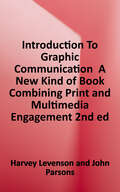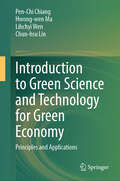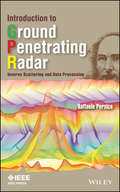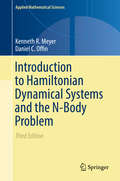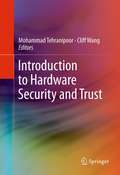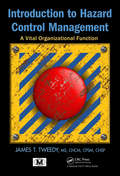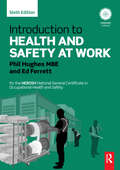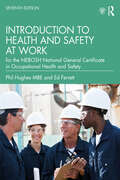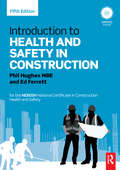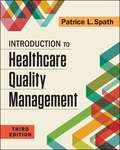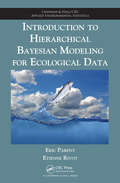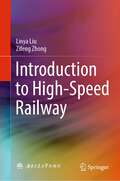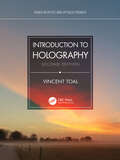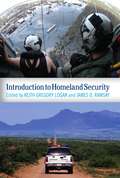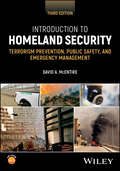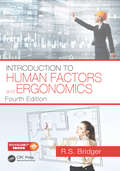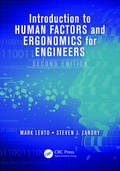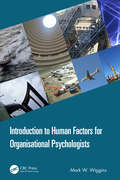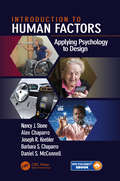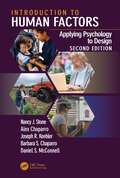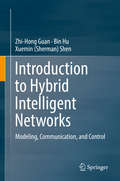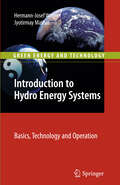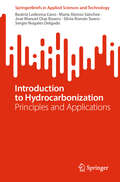- Table View
- List View
Introduction to Graphic Communication: A New Kind of Book, Combining Print and Multimedia Engagement
by John Parsons Harvey LevensonThis book is a survey of the complex world of graphic communication. It is focused largely on print, both conventional and digital, and the processes that make it possible. It is also about the myriad ways digital technology from desktop design to web-based publishing, commerce, and IT affects the art, science, and business of printing.
Introduction to Green Chemistry
by John Andraos Albert S. MatlackInterest in green chemistry and clean processes has grown so much in recent years that topics such as fluorous biphasic catalysis, metal organic frameworks, and process intensification, which were barely mentioned in the First Edition, have become major areas of research. In addition, government funding has ramped up the development of fuel cells and biofuels. This reflects the evolving focus from pollution remediation to pollution prevention. Copiously illustrated with more than 800 figures, the Third Edition provides an update from the frontiers of the field. It features supplementary exercises at the end of each chapter relevant to the chemical examples introduced in each chapter. Particular attention is paid to a new concluding chapter on the use of green metrics as an objective tool to demonstrate proof of synthesis plan efficiency and to identify where further improvements can be made through fully worked examples relevant to the chemical industry. NEW AND EXPANDED RESEARCH TOPICS Metal-organic frameworks Metrics Solid acids for alkylation of isobutene by butanes Carbon molecular sieves Mixed micro- and mesoporous solids Organocatalysis Process intensification and gas phase enzymatic reactions Hydrogen storage for fuel cells Reactive distillation Catalysts in action on an atomic scale UPDATED AND EXPANDED CURRENT EVENTS TOPICS Industry resistance to inherently safer chemistry Nuclear power Removal of mercury from vaccines Removal of mercury and lead from primary explosives Biofuels Uses for surplus glycerol New hard materials to reduce wear Electronic waste Smart growth The book covers traditional green chemistry topics, including catalysis, benign solvents, and alternative feedstocks. It also discusses relevant but less frequently covered topics with chapters such as "Chemistry of Long Wear" and "Population and the Environment." This coverage highlights the importance of chemistry to everyday life and demonstrates the benefits the expanded exploitation of green chemistry can have for society.
Introduction to Green Science and Technology for Green Economy: Principles and Applications
by Pen-Chi Chiang Hwong-wen Ma Lihchyi Wen Chun-hsu LinThis book focused specifically on the newly emerging issues related to the development of green science/technology, and green economy toward Sustainable Development Goals (SDGs). It covers three parts, namely (1) socioeconomic science, (2) environmental science, and (3) development of green technology and economy, each consisting of five to six chapters. The topics covered are meant not only to introduce the basic concepts of green science and technology related to the development of green economy, but also address the challenges, policy instruments, international initiatives and prospective and perspective. More importantly, it presents several innovative idea, indicators and methodologies regarding the measurement of industrial transformation, resource efficiency, green competitiveness, and green trade. To facilitate research innovation/integration and meet the needs for comprehensive education on sustainable development, the book covers a wide range of sectors of major concern in the development of green technology and economy, including green energy, green transportation, green building, green agriculture, and green tourism. The book also features innovation technology and integrated management pervasively adopted worldwide and several unanimous case studies. This book serves a wide range of readers from students, researchers, engineers, policy makers, and entrepreneurs with the emerging challenges, new concepts, innovative methodologies, and integrated strategies it provides. The insights shared from the case studies are also illustrative and inspiring.
Introduction to Ground Penetrating Radar
by Raffaele PersicoThis book presents a comprehensive treatment of ground penetrating radar using both forward and inverse scattering mathematical techniques. Use of field data instead of laboratory data enables readers to envision real-life underground imaging; a full color insert further clarifies understanding. Along with considering the practical problem of achieving interpretable underground images, this book also features significant coverage of the problem's mathematical background. This twofold approach provides a resource that will appeal both to application oriented geologists and testing specialists, and to more research-oriented physicists and engineers.
Introduction to Hamiltonian Dynamical Systems and the N-Body Problem
by Kenneth R. Meyer Daniel C. OffinThis third edition text provides expanded material on the restricted three body problem and celestial mechanics. With each chapter containing new content, readers are provided with new material on reduction, orbifolds, and the regularization of the Kepler problem, all of which are provided with applications. The previous editions grew out of graduate level courses in mathematics, engineering, and physics given at several different universities. The courses took students who had some background in differential equations and lead them through a systematic grounding in the theory of Hamiltonian mechanics from a dynamical systems point of view.This text provides a mathematical structure of celestial mechanics ideal for beginners, and will be useful to graduate students and researchers alike. Reviews of the second edition:"The primary subject here is the basic theory of Hamiltonian differential equations studied from the perspective of differential dynamical systems. The N-body problem is used as the primary example of a Hamiltonian system, a touchstone for the theory as the authors develop it. This book is intended to support a first course at the graduate level for mathematics and engineering students. … It is a well-organized and accessible introduction to the subject … . This is an attractive book … ." (William J. Satzer, The Mathematical Association of America, March, 2009) “The second edition of this text infuses new mathematical substance and relevance into an already modern classic … and is sure to excite future generations of readers. … This outstanding book can be used not only as an introductory course at the graduate level in mathematics, but also as course material for engineering graduate students. … it is an elegant and invaluable reference for mathematicians and scientists with an interest in classical and celestial mechanics, astrodynamics, physics, biology, and related fields.” (Marian Gidea, Mathematical Reviews, Issue 2010 d)
Introduction to Hardware Security and Trust
by Cliff Wang Mohammad TehranipoorThis book provides the foundations for understanding hardware security and trust, which have become major concerns for national security over the past decade. Coverage includes security and trust issues in all types of electronic devices and systems such as ASICs, COTS, FPGAs, microprocessors/DSPs, and embedded systems. This serves as an invaluable reference to the state-of-the-art research that is of critical significance to the security of, and trust in, modern society's microelectronic-supported infrastructures.
Introduction to Hazard Control Management: A Vital Organizational Function
by James T. TweedyThe International Board for the Certification of Safety Managers (IBFCSM) has designated this text as the Primary Study Reference for those preparing to sit for the Certified Hazard Control Manager (CHCM) and the Certified Hazard Control Manager-Security (CHCM-SEC) Examinations. Introduction to Hazard Control Management: A Vital Organizational Func
Introduction to Health and Safety at Work: for the NEBOSH National General Certificate in Occupational Health and Safety
by Phil Hughes Ed FerrettIntroduction to Health and Safety at Work covers the fundamentals of occupational safety and health for the thousands of students who complete the NEBOSH National General Certificate in Occupational Health and Safety each year. Fully revised in alignment with the April 2015 syllabus, this sixth edition provides students with all they need to tackle the course with confidence. The highly illustrated content covers all of the essential elements of health and safety management, the legal framework, risk assessment and control standards and also includes checklists, report forms and record sheets to supplement learning. Aligned to the NEBOSH National General Certificate in Occupational Health and Safety Practice questions and answers to test knowledge and increase understanding Complete with a companion website containing extra resources for tutors and students at www.routledge.com/cw/hughes Written by renowned authors, the Introduction to Health and Safety at Work is also a handy reference for managers and directors dealing with the day-to-day issues of health and safety and is of great value to those studying for level 3 N/SVQ and the NEBOSH National Diploma.
Introduction to Health and Safety at Work: for the NEBOSH National General Certificate in Occupational Health and Safety
by Ed Ferrett Phil Hughes MBEIntroduction to Health and Safety at Work covers the fundamentals of occupational safety and health for the thousands of students who complete the NEBOSH National General Certificate in Occupational Health and Safety each year. This seventh edition closely follows the NEBOSH National General Certificate syllabus which was updated in 2019 and comes into use in 2020. The highly illustrated content covers all of the essential elements of health and safety management, the legal framework, risk assessment and control standards and also includes checklists, report forms and record sheets to supplement learning. It also has an extensive summary of current health and safety legislation. • Aligned to the NEBOSH National General Certificate in Occupational Health and Safety • Practice questions and answers to test knowledge and increase understanding • Complete with a companion website containing extra resources for tutors and students The book is suitable for all students following a level 3 Health and Safety course and a source of reference and guidance for managers at work in the UK. Written by renowned authors, this book is often provided as part of the Certificate course and is essential reading for a student.
Introduction to Health and Safety at Work: for the NEBOSH National General Certificate in Occupational Health and Safety
by Ed Ferrett Phil Hughes MBEIntroduction to Health and Safety at Work covers the fundamentals of occupational safety and closely follows the NEBOSH National General Certificate syllabus which was updated in 2019 and came into use in 2020.Highly illustrated and over 600 pages in length, it covers all of the essential elements of health and safety management, the legal framework, risk assessment and control standards and also includes checklists, report forms and record sheets to supplement learning. It also has an extensive summary of current health and safety legislation. Aligned to the NEBOSH National General Certificate in Occupational Health and Safety Practice questions and answers to test knowledge and increase understanding In addition to helping students study for the NGC, it is used for reference and revision on other Health and Safety qualifications at level 3 and above, including the Nebosh Diploma. It is also a source of reference and guidance for health and safety practitioners in the workplace.
Introduction to Health and Safety in Construction: for the NEBOSH National Certificate in Construction Health and Safety
by Phil Hughes Ed FerrettIntroduction to Health and Safety in Construction has been specially written for the thousands of students who complete the NEBOSH National Certificate in Construction Health and Safety each year. Fully revised in alignment with the April 2015 syllabus, the fifth edition provides students with all they need to tackle the course with confidence. The book covers all the essential elements of health and safety management in construction including the legal framework, risk assessment and control standards. Highly illustrated, with information provided in a clear, easily accessible format, it also provides checklists and record sheets to supplement learning. Aligned to the NEBOSH National Certificate in Construction Health and Safety Practice questions and answers to test knowledge and increase understanding Complete with a companion website containing extra resources for tutors and students at www.routledge.com/cw/hughes The only textbook endorsed for the NEBOSH National Certificate in Construction Health and Safety, the Introduction to Health and Safety in Construction is also suitable for construction courses in the UK and overseas and serves as a comprehensive reference for managers and professionals within the construction industry.
Introduction to Healthcare Quality Management (Gateway to Healthcare Management)
by Patrice L. SpathIntroduction to Healthcare Quality Management explains the basic principles and techniques of quality management in healthcare. Written for students and professionals with little or no clinical experience, the book focuses primarily on measuring and improving the operational and patient service aspects of healthcare delivery.
Introduction to Hierarchical Bayesian Modeling for Ecological Data (Chapman & Hall/CRC Applied Environmental Statistics)
by Eric Parent Etienne RivotMaking statistical modeling and inference more accessible to ecologists and related scientists, Introduction to Hierarchical Bayesian Modeling for Ecological Data gives readers a flexible and effective framework to learn about complex ecological processes from various sources of data. It also helps readers get started on building their own statisti
Introduction to High-Speed Railway
by Linya Liu Zifeng ZhongThis book provides a comprehensive overview of various aspects of high-speed railways, such as infrastructure, communication signals, traction power supply, trainsets, and transportation organization. It delves into the basic concepts, fundamental theories, and the latest technological achievements in these areas, equipping readers with a strong foundation in the subject matter. The content is organized into eight chapters: Introduction, High-Speed Railway Lines and Infrastructure, Power Supply Systems, High-Speed Railway Trainsets, Signal and Communication Systems, Transportation Organization, Passenger Services, and Maglev Railways. Each chapter explores different facets of high-speed railway systems, focusing on the unique characteristics, design principles, and operational methodologies that set them apart from traditional railway systems. The book also highlights recent breakthroughs and innovations in the field, giving readers a glimpse of the future potential of high-speed railways. The book is tailored to meet the needs of undergraduate and graduate students pursuing degrees in railway transportation, railway engineering, locomotive vehicles, electrical traction, signal communication, and related fields. It offers a systematic and in-depth understanding of high-speed railway systems, enabling students to grasp the subject matter and apply their knowledge to real-world situations. It can also be a training material for railway professionals looking to expand their knowledge and skills in high-speed railway systems. Furthermore, the book can be a useful reference for postgraduate students engaged in research in relevant fields. It offers a wealth of information and insights, assisting researchers in understanding the intricacies of high-speed railway systems, and exploring new avenues for innovation and improvement.
Introduction to Holography (Series in Optics and Optoelectronics)
by Vincent ToalThis fully updated second edition of Introduction to Holography provides a theoretical background in optics and holography with a comprehensive survey of practical applications. It is intended for the non-specialist with an interest in using holographic methods in research and engineering. The text assumes some knowledge of electromagnetism, although this is not essential for an understanding of optics, which is covered in the first two chapters. A descriptive approach to the history and principles of holography is followed by a chapter on volume holography. Essential practical requirements for successful holographic recording are explained in detail. Recording materials are considered with detailed discussions of those in common use. Properties peculiar to holographically reconstructed images are emphasised as well as applications for which holography is particularly suitable. Mathematical tools are introduced as and when required throughout the text with important results derived in detail. In this new edition, topics such as photopolymers, dynamic holographic displays, holographic optical elements, sensors, and digital holography are covered in greater depth. New topics have been added, including UV and infrared holography, holographic authentication and encryption, as well as particle beam, X-ray, and acoustic holography. Numerical problems are provided at the end of each chapter. This book is suitable for undergraduate courses and will be an important resource for those teaching optics and holography. It provides scientists and engineers with knowledge of a wide range of holographic applications in research and industry, as well as an understanding of holography’s potential for future use.
Introduction to Homeland Security
by Keith Gregory Logan James D. RamsayThis book introduces students to the dynamic and complex enterprise that is homeland security. Using a broad lens, the authors explore key operational and content areas, as well as the practices and policies that are part of an effective homeland security program. With original essays from academics and practitioners, the book encapsulates the breadth of homeland security as it exists today. Topical coverage includes: administration, intelligence, critical infrastructure protection, emergency management, terrorism and counterterrorism, law and policy, technology and systems, strategic planning, strategic communication, civil-military affairs, private sector involvement, environmental security, and public health. Accessible, engaging, and comprehensive, this is an essential resource for courses on homeland security.
Introduction to Homeland Security: Terrorism Prevention, Public Safety, and Emergency Management
by David A. McEntireExplore the growing concerns about security with this vital book Homeland Security has never been a more important part of the American social and political fabric. Risk assessment, attack prediction and prevention, preparedness measures, response to terrorist activity, and natural disaster management all fall under the purview of homeland security. It is a key focus of the US security state, which has expanded massively in recent decades. Introduction to Homeland Security provides an overview of this subject for professors, students, and practitioners in the field. Drawing upon a rich foundation of scholarship and academic literature, it focuses principally on terrorism prevention and protection, and offers new content related to novel threats and security concerns. Its practitioner-centered approach and attention to both governmental and non-governmental stakeholders make it an indispensable introduction to the subject. Readers will also find: Coverage of the four traditional phases of emergency management New and additional treatment of border control, drug trafficking, organized crime, mass shootings, protests, riots, pandemics, and climate change Companion websites including extensive pedagogical materials, student self-assessment tests, and an image gallery Introduction to Homeland Security is ideal for professors and students in homeland security and emergency management programs, as well as practitioners involved in this important profession.
Introduction to Human Factors and Ergonomics
by Robert BridgerBuilding on the success of previous editions, the 4th edition of ‘Introduction to Human Factors and Ergonomics’ provides a comprehensive and up to date introduction to the field. The new edition places the subject matter into a system context using a human-machine model to structure the chapters and a knowledge application model to structure the organisation of material in each chapter. Every chapter covers: Core Concepts, Basic Applications, Tools and Processes, and System Integration issues regardless of topic. Includes over 200 exercises and essays (at least ten per chapter). An Instructor’s Manual, A Guide to Tutorials and Seminars and and over 500 powerpoint slides are available for academic users from the publisher. All chapters contain ‘HFE Workshop’ sections with practical guidance and worked examples. Please see the TOC for more information.
Introduction to Human Factors and Ergonomics for Engineers (Human Factors and Ergonomics)
by Mark R. Lehto Steven J. LandryWith a practical, applied orientation, this book presents and integrates in a single source important methods and tools used in the fields of industrial engineering, human factors and ergonomics to design and improve jobs, tasks and products. The author covers such topics as the human system, motion analysis, predicting human performance, simulation in ergonomic design, product quality and usability, macroergonomics, and occupational safety and health. Each chapter offers challenging problems and examples to illustrate concepts. The new second edition features two new chapters that address human error causation and reduction and human computer interaction. It also includes updated figures.
Introduction to Human Factors for Organisational Psychologists
by Mark W. WigginsThis text introduces industrial and organisational psychologists to the discipline of human factors. It also provides a range of tools necessary for the application of human factors strategies and techniques in practice. The text is intended to respond to the growing demand for organisational psychologists to assist in the development and evaluation of initiatives that are intended to optimise the relationship between workers and the operational environments with which they engage. The book • Contains practical strategies and examples that are intended to guide readers • Combines human factors and organisational psychological concepts in a single volume • Covers context-related examples that illustrate the application of human factors tools and principles • Presents an integrated approach to human factors from an organisational psychological perspective The text begins by discussing the application of human factors in organisations, together with notions of risk and uncertainty. Frameworks for human factors are considered, including error-based and system safety approaches. It explores the links between individual differences and human factors, and it covers group processes and the impact on team performance, including the role of leadership and followership. The book also presents a range of tools and techniques that can be applied by organisational psychologists to acquire human factors-related information and develop an understanding of the situation or factors that may explain human behaviour.
Introduction to Human Factors: Applying Psychology to Design
by Nancy J. Stone Alex Chaparro Joseph R. Keebler Barbara S. Chaparro Daniel S. McConnellThis is a comprehensive, but accessible text that introduces students to the fields of human factors and ergonomics. The book is intended for undergraduate students, written from the psychological science perspective along with various pedagogical components that will enhance student comprehension and learning. This book is ideal for those introductory courses that wish to introduce students to the multifaceted areas of human factors and ergonomics along with practical knowledge the students can apply in their own lives.
Introduction to Human Factors: Applying Psychology to Design, 2nd Edition
by Nancy J. Stone Alex Chaparro Joseph R. Keebler Barbara S. Chaparro Daniel S. McConnellThis textbook comprehensively introduces readers to the cutting-edge field of human factors psychology, offering real-world examples illustrating how experimental findings can be used to improve the design of tools and environments that we use every day. The revised second edition provides updated text, examples, pedagogical boxes, and references.Features: Showcases pedagogical boxes that end with thought questions to encourage student processing and application of the material Includes instructor materials such as PowerPoint slides, activities, and exam items to facilitate teaching for instructors who are new to the course Presents theoretical and practical implications of applying psychology to design with the use of examples Discusses anthropometric tools, anthropometric data collection methods, hand biomechanics, and hand tools Highlights diversity and inclusion with applications to the special population section in each chapter Introduction to Human Factors is an ideal read for senior undergraduate and graduate students in the fields of ergonomics, human factors, and psychology.Online teaching resources accompany this textbook, including PowerPoints, a test bank with answers, and an end-of-chapter questions and answers key for the instructors.
Introduction to Hybrid Intelligent Networks: Modeling, Communication, and Control
by Bin Hu Xuemin Sherman Shen Zhi-Hong GuanThis book covers the fundamental principles, new theories and methodologies, and potential applications of hybrid intelligent networks. Chapters focus on hybrid neural networks and networked multi-agent networks, including their communication, control and optimization synthesis. This text also provides a succinct but useful guideline for designing neural network-based hybrid artificial intelligence for brain-inspired computation systems and applications in the Internet of Things.Artificial Intelligence has developed into a deep research field targeting robots with more brain-inspired perception, learning, decision-making abilities, etc. This text devoted to a tutorial on hybrid intelligent networks that have been identified in nature and engineering, especially in the brain, modeled by hybrid dynamical systems and complex networks, and have shown potential application to brain-inspired intelligence. Included in this text are impulsive neural networks, neurodynamics, multiagent networks, hybrid dynamics analysis, collective dynamics, as well as hybrid communication, control and optimization methods. Graduate students who are interested in artificial intelligence and hybrid intelligence, as well as professors and graduate students who are interested in neural networks and multiagent networks will find this textbook a valuable resource. AI engineers and consultants who are working in wireless communications and networking will want to buy this book. Also, professional and academic institutions in universities and Mobile vehicle companies and engineers and managers who concern humans in the loop of IoT will also be interested in this book.
Introduction to Hydro Energy Systems: Basics, Technology and Operation
by Hermann-Josef Wagner Jyotirmay MathurThe authors have tried to strike a balance between a short book chapter and a very detailed book for subject experts. There are three prime reasons behind for doing so: first, the field is quite interdisciplinary and requires simplified presentation for a person from non-parent discipline. The second reason for this short-version of a full book is that both the authors have seen students and technically oriented people, who were searching for this type of book on hydro energy. The third reason and motivation was considering engineers who are starting their career in hydro energy sector. This book is targeted to present a good starting background and basic understanding for such professionals.
Introduction to Hydrocarbonization: Principles and Applications (SpringerBriefs in Applied Sciences and Technology)
by Sergio Nogales Delgado Beatriz Ledesma Cano María Alonso Sánchez José Manuel Díaz Rasero Silvia Román SueroThe book is a comprehensive exploration of hydrothermal carbonization (HTC), addressing key aspects from its definition and historical relevance to its practical applications and environmental considerations. Throughout its sections, the reader will gain an understanding of the fundamental principles of HTC, including the chemical reactions involved and the catalysts used. In addition, the book provides a comprehensive overview of the various types of waste that can be utilized in the process, from organic sources to industrial and municipal solid wastes. Highlighting the importance in various industries and research areas, case studies illustrating successful applications are presented. A practical perspective is also provided, including exercises for students, exploring laboratory techniques and experiments related to hydrocarbonization. In addition, its focus on research and innovation, addressing current trends and emerging technologies, positions this book as a valuable source for students, researchers, and professionals interested in exploring and developing this field with an emphasis on its potential impact on energy, the environment, and sustainability. The conclusion provides a concise summary of key concepts, a discussion of the future of hydrocarbonization, and an encouragement for students to venture into research in this promising field.
